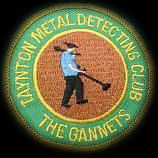
Responsible Detecting
Introduction
Recovering Our Past
Recording Our Past
Displaying Our Past
Heritage Centre
Donations
Lost Items
Rubbish Removal

Recording Our Past
All club members are required to submit their finds, with the exact National Grid Reference of the findspot, to our recording officer who photographs them and enters them on the club database. Interesting finds are shown to the Gloucestershire Finds Liason Officer at the next club meeting and details of the more important finds are then fed onto the Portable Antiquities Scheme and the Monuments Record Office.
Club Database
Ploughing mixes up the first 20cm or so of soil, such that finds lost in the same historic period are dispersed to different depths, a few being brought near enough to the surface that we can detect them, others being buried deeper down out of our range. Most of our find are random losses and are therefore usually few for any period from any field in any one year. In order to best identify past activity you need to visit the same field over several years so that a number of related finds build up to a level where past activities can be identified. By recording the findspot and details of every find within our club database we ensure that all of our finds are available for such research. Detecting as a club rather than individuals allows us to provide a larger pool of finds for local historical analysis. Our database is particularly useful because we detect on many adjacent farms allowing us to track past activity across modern boundaries, thanks to many local farmers recognising the benefits to the local community of letting the club record their farm history and display the finds locally.
Portable Antiquity Scheme
Recording metal detecting finds compliments archaeology. Metal detectorists operate in ploughed fields where the disturbed ground is unsuitable for archaeological digs, covering a wide area and mainly finding random losses. Archaeoligists dig small areas of undisturbed past habitation, which normally only survive for high status buildings or graveyards, mainly finding deliberately abandoned or deposited artefacts. Metal detecting finds stored in the national Portable Antiquity Scheme databases allow university researchers to plot distributions of particular items across the country to identify broad trends such as patterns of trade, regions of manufacture and ethnic boundaries. The PAS database has already been used to identify several broad historic trends previously invisible to archealogical digs and historic documents.
Portable Antiquity Scheme leaflets: